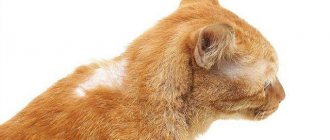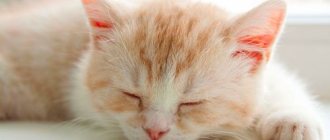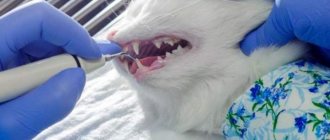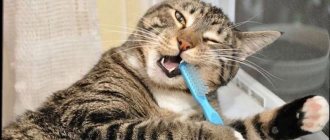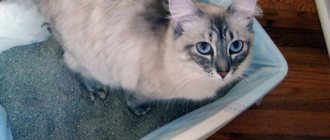Cats' teeth can normally fall out only twice in their life: in childhood - when changing from a primary bite to a permanent one - and in old age. All other cases are associated with diseases and genetic factors.
Some breeds are prone to oral problems and calcium metabolism disorders, so it is important to carefully select a kitten from a pure line.
Causes of tooth loss
All factors can be divided into pathological and physiological. The symptoms are not always cause for concern.
Physiological
At the age of four months to six months, kittens begin to replace their baby teeth with permanent ones. This process lasts for about a year and does not cause any concern. This is a normal physiological phenomenon.
Older cats may also lose teeth. Often such changes are observed after the pet reaches the age of ten.
True, with a properly organized diet, sufficient supply of necessary substances to the body, and regular hygiene procedures, the animal may not encounter such a problem until old age.
Pathological
If a young cat loses its front molars or canines, this may be due to pathological reasons.
Among them are the following:
- dysbacteriosis of the oral cavity;
- getting injured;
- suppression of the immune system;
- nutritional deficiencies;
- long-term use of antibacterial or hormonal drugs;
presence of tartar;- pathologies of gums and teeth. For example, stomatitis, periodontitis, pulpitis;
- damage to the body by viruses or infections;
- improperly formed bite;
- malignant processes;
- gastrointestinal diseases.
Which breeds are more susceptible
Not a single pet is immune from the pathological process, but there are a number of breeds that are more susceptible to such problems.
It has been noted that this occurs more often in cats with a flattened short muzzle, for example, Persians, Scots and British cats.
What cat breeds are prone to early tooth loss?
Breeds of animals that are bred for commercial purposes are predisposed to developmental anomalies. Spontaneous selection has led to the appearance among short-faced pets of individuals predisposed to premature loss of teeth.
These include cats of the following breeds:
- Persov;
- Exotics;
- Burmantsev;
- Ragdoll;
- Britanov;
- Scots;
- Abyssinok.
Conscientious felinologists exclude pets with dental anomalies from breeding.
What you should pay attention to
The owner should be alert to the loss of permanent teeth in young cats. Such changes occur for pathological reasons. Normally they should not be.
The following symptoms are reasons to contact a veterinarian:
- excessive salivation;
- unpleasant, strong odor from the mouth;
- redness, swelling of the gums;
- bloody discharge from the mouth;
- the appearance of ulcers on the gums;
- formation of abscesses, presence of pus in saliva.
You also need to pay attention to changes in the cat's behavior.
The onset of the pathological process is indicated by irritability, periodic aggressiveness, and refusal to eat. When an animal tries to eat, it does it very slowly, chewing only on one side. The pet also begins to drink reluctantly.
How to help an animal?
With proper care and a balanced diet, cats' teeth serve them well into old age. Experts will help you find out why an adult cat’s fang fell out. The fact that a healthy animal loses a tooth often signals a health problem. It could be:
- Decreased immunity level.
- Lack of vitamins.
- Damage and microtrauma of the oral cavity.
- Formation of tartar.
- Changes in metabolic processes.
- Taking antibiotics.
- Infectious diseases.
- Stomach diseases.
Careful observation of your pet will help the doctor make the correct diagnosis. Depending on the reasons, the specialist will give recommendations on the choice of food, medications and products that strengthen the cat’s gums and teeth. If necessary, the cat will undergo surgery to remove tartar at the veterinary clinic.
Watch a video about changing teeth in kittens.
Cats cope with many diseases without human help. When a cat's fang falls out and his gums are swollen, the pet needs help. Before contacting the veterinarian, we should treat the gums with special ointments. At the same time, it is not at all necessary to look for medications in veterinary pharmacies. Similar remedies for treating inflammation of the human oral cavity are perfect for a caudate family member. You need to carefully treat the problem area with the chosen drug and make an appointment with a doctor as soon as possible.
But if a cat’s fang falls out, but the root remains, you cannot do without specialists. Only urgent removal can relieve the animal from pain. Otherwise, the gums will become inflamed at the root. If the owner has the desire and opportunity, doctors offer to put a crown on a broken tooth. However, this procedure has many disadvantages. For example, grinding down a tooth can cause gum inflammation. The implant will cause discomfort to the cat, or simply will not take root. A pet is quite capable of living without fangs until old age.
The kitten's fang fell out: what to do?
If a kitten's fang falls out, this is normal. Kittens, just like regular children, lose their baby teeth as they grow up. A kitten's behavior changes during the period of teeth change. Small cats and cats begin to chew everything that comes into their field of vision. This happens because their gums itch very much where their permanent teeth erupt.
At such times, the owner must be sure to keep track of what exactly the kitten came across. Plastic items and wires are dangerous to the baby's health. If a kitten loses its lower fang, it means it is turning into a cat. The change of teeth begins with the lower dentition. The fact that the pet is growing up and its baby teeth are being replaced by permanent ones will also be indicated by some changes in its physiology and behavior.
- salivation increases;
- tooth mobility and slight bleeding of the gums appear;
- appetite decreases;
- The animal is constantly gnawing on something.
Read about how to properly cut a cat's nails. And also about how long a cat walks for the first time.
Caring for a kitten during this period requires constant treatment of the oral cavity. The animal's food should contain a lot of products containing calcium and vitamin C (kefir, cottage cheese).
Permanent teeth in cats, unlike humans, grow next to the baby teeth. Therefore, the owner does not need to be scared and wonder what to do: the kitten’s fang did not fall out, but another one suddenly grew nearby. The extra fangs will fall off painlessly over time.
Preventing tooth loss in cats
The basis of the physical health of the body as a whole, and the health of the animal’s oral cavity, depends on proper nutrition. A balanced menu with vitamins and minerals is the key to good metabolism, digestion, and an active lifestyle.
Outdoor cats clean their teeth by chewing tree branches and grass. Domestic cats need help from their owner. High-quality cat food certainly contains 20% (at least) protein. The diet combines soft and rough food. In no case are starch or preservatives allowed in the food.
Owners of Persian and Abyssinian cats should take into account that their pets are genetically more susceptible to oral diseases. Therefore, they will benefit from frequent examinations at the veterinary clinic. After all, it is easier to prevent any illness than to overcome its consequences.
If possible, domestic cats should have their teeth brushed at least twice a month. However, cats actively resist this much-needed procedure. To make the process of cleaning the fangs easier to tolerate, the kitten should be accustomed to it from 4-5 months. In addition to cat toothpastes with fish or chicken flavors, special cleaning treats have been created. Their task is to strengthen tooth enamel and prevent the formation of tartar in tailed family members.
If a kitten loses a fang, will a new one grow in its place? Yes, provided that it is a milk canine, the veterinarians will say. If an adult cat loses a fang, will a new one grow? The answer to this question will be negative. Unfortunately, nature did not provide such an opportunity for either cats or people.
Have your pets ever lost teeth? Share your experience in the comments! And also watch a video about caring for cats' teeth.
How is the diagnosis carried out?
The process is not considered an independent disease, but a symptom of a serious disease affecting the body.
The exception is injuries sustained. Diagnostic measures are aimed at determining the cause of such changes.
The veterinarian collects information about the cat’s diet and living conditions and listens to the owner’s complaints.
A visual examination of the pet is also carried out, and additional tests may be prescribed.
Why did the cat's fang fall out?
Veterinarians consider the main factors for tooth loss to be:
- replacement of baby teeth in kittens;
- animal disease;
- age-related loss;
- mechanical loss of a tooth (for example, due to an unsuccessful fall from a height).
For a pet, losing its fangs is not as scary as for its wild relative. Cats need their fangs for hunting; they do not take part in chewing food. What to do if a cat’s fang falls out after an injury? Experienced owners advise taking a closer look at their pet’s behavior. In cases where the animal does not show signs of anxiety and remains active and playful, there is no cause for concern. However, if your pet's usual behavior changes, you should contact a veterinarian.
Treatment: what the doctor prescribes
Therapy is selected individually, taking into account the reasons that led to such changes. The main goal of its implementation is to eliminate the provoking factor and normalize the animal’s condition.
Nutrition correction
The first thing to do is to adjust the animal’s diet.
It is extremely important that the menu is balanced . It should contain a sufficient amount of vitamins and microelements.
Tartar removal
If necessary, remove hard plaque under anesthesia. The pet is conscious, but cannot offer resistance.
Upon completion of the process, the cat needs to be provided with complete care. The procedure is very stressful for him.
Treatment of the underlying disease
The main emphasis is on eliminating the pathology that provoked tooth loss. For this purpose, immunostimulating, anti-inflammatory drugs and antibiotics can be prescribed. The therapy is aimed at strengthening the gums, eliminating bleeding and pain.
When do kittens lose their baby teeth?
Kittens are born toothless. At 7–14 days of age, their primary incisors appear. By 2 months, babies should normally have 26 teeth. As they grow older, they fall out and permanent units grow in their place. Hair loss begins at 3–4 months of age. The process of changing teeth takes approximately 3–4 months, being completely completed by 7–8 months.
The first to erupt are the permanent incisors - the anterior units responsible for biting food. Then fangs appear, which perform the function of holding and tearing food. The last to be cut are the molars and premolars. Chewing teeth have the thickest walls and the widest bases to serve their owner for at least the next 7–8 years.
What should the owner do?
The pet owner must strictly follow the veterinarian's recommendations. Self-medication is unacceptable. In such a situation, the animal may suffer irreparable harm.
The selection of medications and determination of their dosage should be carried out exclusively by a specialist.
The doctor will also tell you about the cat’s nutrition during the treatment period. It is recommended to change the consistency of the food: dry granules injure already inflamed mucous membranes. It is recommended to give preference to soft food.
It is necessary to systematically examine the oral cavity and treat it with a Chlorhexidine solution. In this way, it will be possible to avoid destruction and infection of the enamel and damage to other teeth.
Tartar removal
Tartar causes pain and tooth loss. Fangs are most often affected. Owners of four-legged pets should know what to do when a cat's fang falls out and how to prevent the loss of other teeth.
The stone is removed independently:
- Can be treated with hydrogen peroxide. Moisten the gauze and clean the problem area. Rinse your mouth with a decoction of herbs.
- They are given toothpick toys to chew on.
- Use a silicone brush - put it on your finger and clean the sore spot.
- Polish the stone with a cloth soaked in a special solution.
Note! When they can’t cope, they go to the vet. The doctor removes the stone manually or with ultrasound.
Oral hygiene - prevention of dental diseases
Preventive measures
Avoiding such problems is much easier than dealing with their consequences later. To this end, it is worth following a number of recommendations.
Regular teeth cleaning
To avoid the formation of tartar, it is recommended that your pet regularly brush its teeth.
True, cats walking outside clean their mouths themselves. They have it in their nature. We are talking about pets. For this purpose, special pastes are used, which are available at the veterinary pharmacy. There is no need to wash them off with water.
The use of human hygiene products is prohibited. Cleaning is done with a special or children's brush. The main thing is that the bristles are soft.
Balanced diet
If the owner feeds the animal with natural food, then the pet’s menu should include fermented milk products, vegetables, fish and meat.
When using dry food, the choice is made on premium products. It contains the necessary concentration of nutrients.
Regular examinations by a specialist
At least once a year you need to visit a veterinary clinic and have your pet examined. In this way, it will be possible to identify the disease at the initial stage of its development.
Is missing teeth harmful for a cat?
In the wild, a toothless cat is doomed to starvation. The fate of domestic cats is different: food manufacturers produce special food that allows animals with an incomplete set of teeth to feel good.
Be sure to read:
Interpretation of blood tests in cats: features of the procedure, types, main indicators, norms
In what cases does a veterinarian recommend tooth extraction?
Let's look at the cases in which teeth are removed.
- Incorrect placement of milk or molars, which interferes with the normal functioning of the animal - the soft tissues of the oral cavity are damaged.
- In severe cases, where conventional treatment has not yielded results - feline lymphoplasmacytic stomatitis.
- Teeth that are close to each other is called crowding. In this case, there is a risk of getting sick because Food will accumulate between the teeth and this will lead to an inflammatory process.
- Internal root resorption
- External root resorption
- Milk teeth that did not fall out on time on their own, but the molars have already begun to grow and the milk teeth interfere with the growth of new teeth.
- Teeth located under the gum mucosa are also subject to removal. They have not erupted, but a cyst may form under the gum and this will harm the adjacent teeth.
- The indication for tooth extraction is periodontal disease.
- Odontoclastic resorptive lesion of teeth – classes 2,3,4
Tooth extraction is carried out only under anesthesia. After tooth extraction, your pet must have the wound sutured, otherwise there is a risk of infection, and the wound will take a long time to heal.
How can you tell if your teeth have changed?
The appearance of permanent teeth differs from temporary teeth. Milk ones, as a rule, are very sharp, akin to a well-sharpened dagger; the fangs have a curved shape and thinning in the gum area. While the permanent canines are straight and more rounded at the ends, and the neck is without thinning.
By the way, when changing teeth, you should not be afraid of the so-called polyteeth, when a kitten suddenly has 8 fangs instead of 4. The fact is that the molars are not formed in the same alveolus as the temporary ones, but nearby. So it turns out that one fang has not yet fallen out, but a new one has already grown.
In rare cases, a growing tooth pinches the root of the milk tooth, then the kitten begins to feel discomfort: it does not eat, periodically squeals pitifully and generally feels unwell. The problem is not global and is easily solved by removing the extra tooth.
You should not try to remove it yourself; it is better to take your baby to the veterinarian. It is possible that local or general anesthesia will be required. At the same time, the doctor will check for what reason the pathology occurred (perhaps the kitten has an incorrect bite or a developmental anomaly).
Features of caring for a kitten during teeth change
During the period of teeth formation, it is necessary to brush your kitten's teeth regularly.
The formation of a healthy dental system depends on the content of phosphorus and calcium in the body. During the period when the baby’s teeth are changing, the owner must take care of the additional introduction of mineral salts into the diet, which is easily achieved by giving food rich in calcium (cottage cheese, milk, kefir, etc.), as well as by using veterinary drugs containing the necessary for strong enamel substance. Most often, these products are vitamins with a complex of minerals.
In addition, periodic examination and timely care of the kitten’s oral cavity will not hurt. Sanitation is carried out weekly with a chlorhexidine solution. This will help kill harmful microbes, which will prevent the development of an infectious process on tooth enamel, and consequently, tooth loss in later life.
There are special dental tablets containing a disinfectant. By sticking to the mucous membrane for a short time, they prevent the occurrence of dental diseases.
Don't forget about regular cleaning. For this, there are special toothpastes with a pleasant fish or meat taste for the kitten. The product is rubbed into the enamel using a special brush or fingertip with rubber spikes. We also recommend reading the article about cat dental care.
